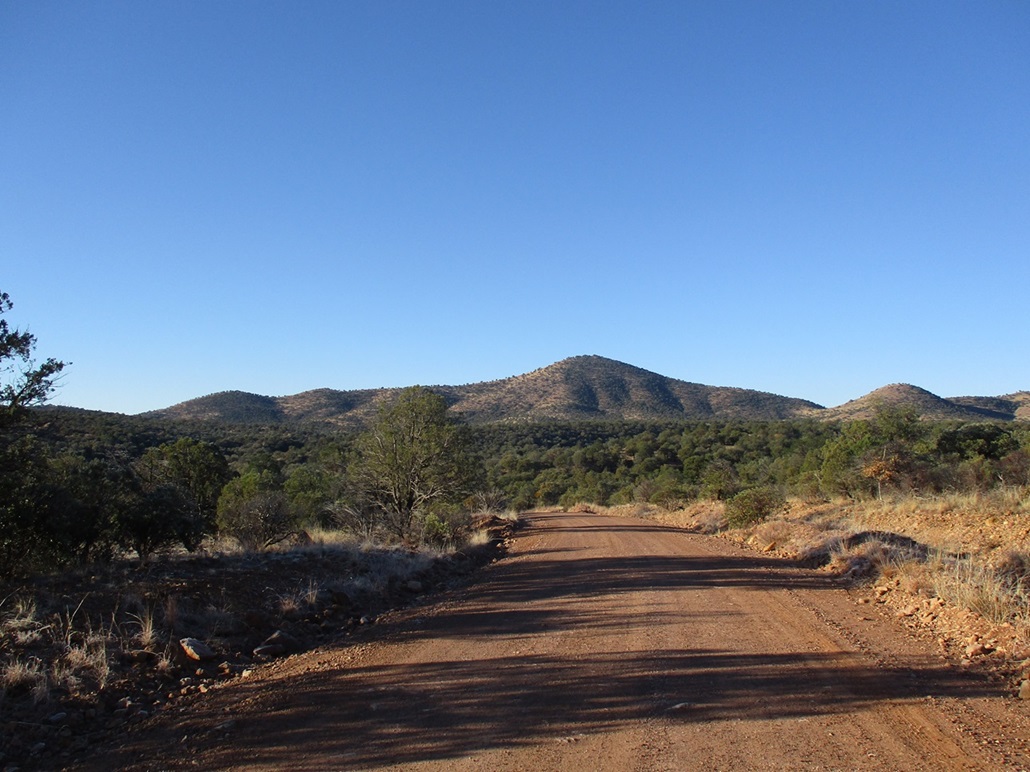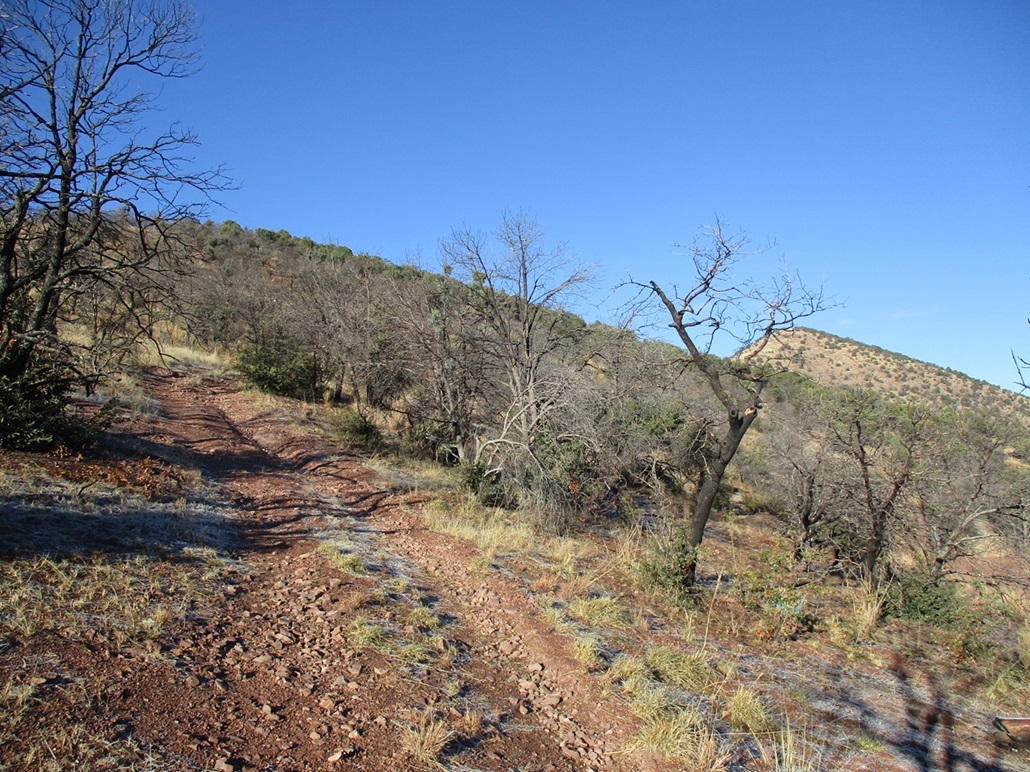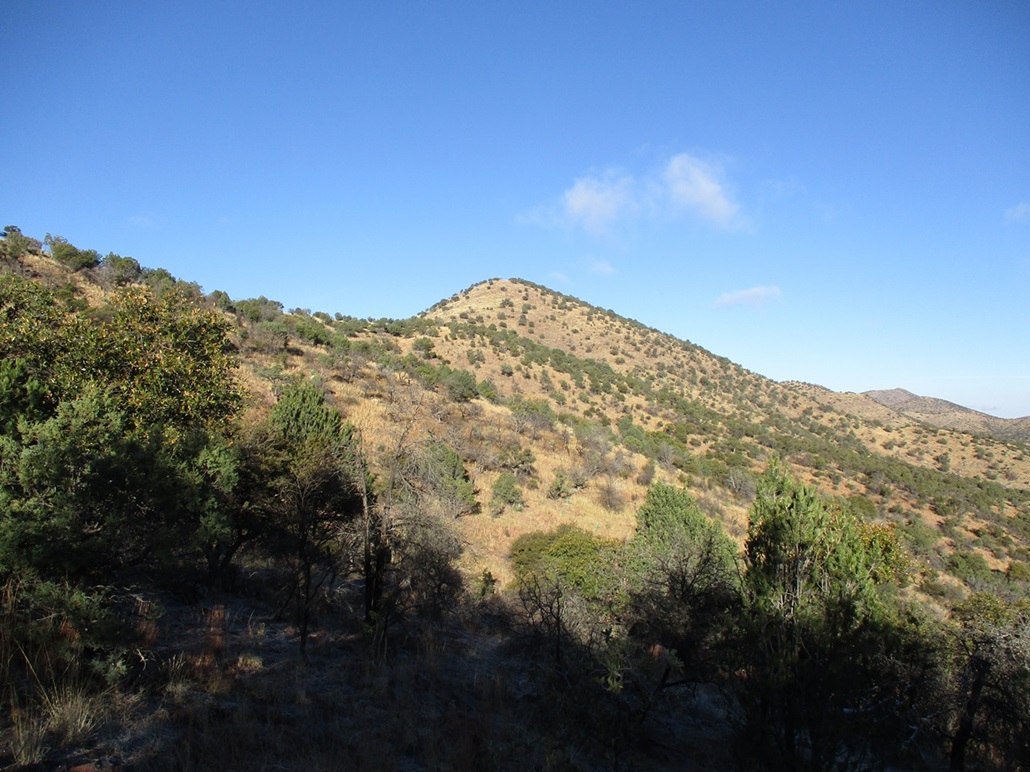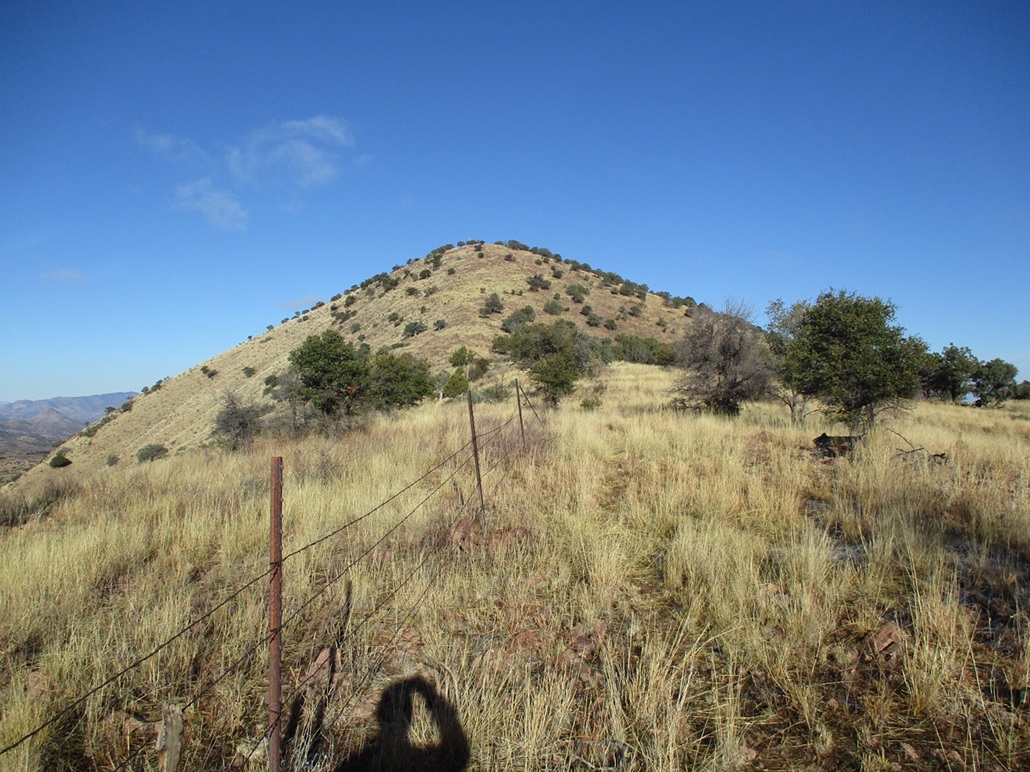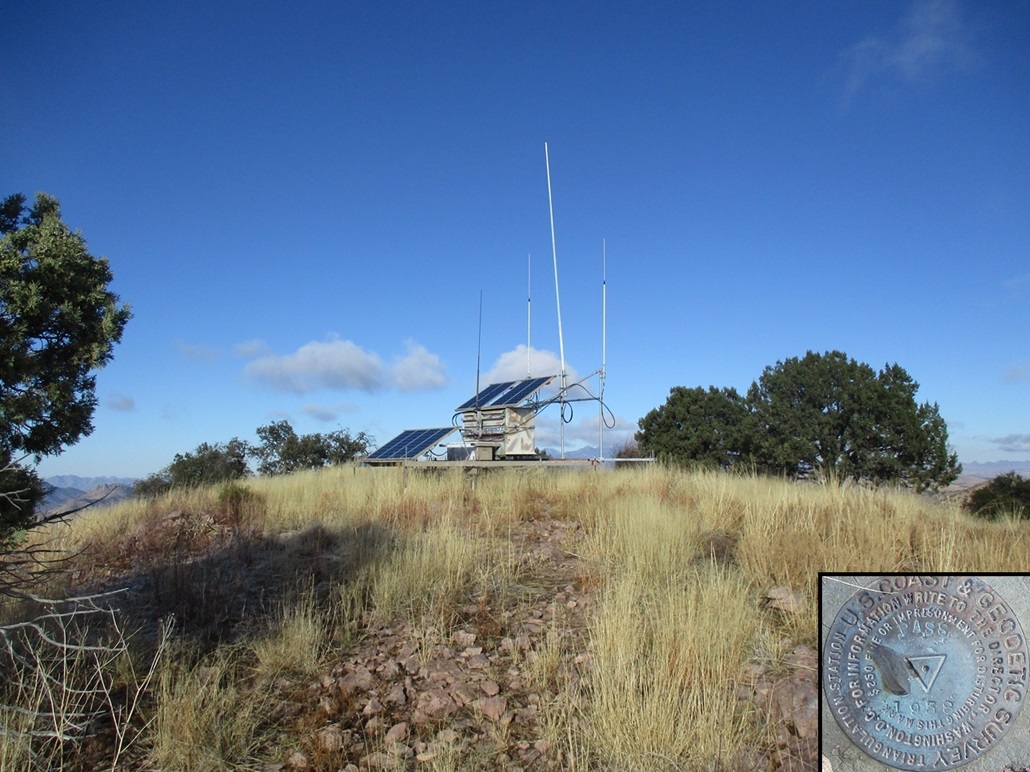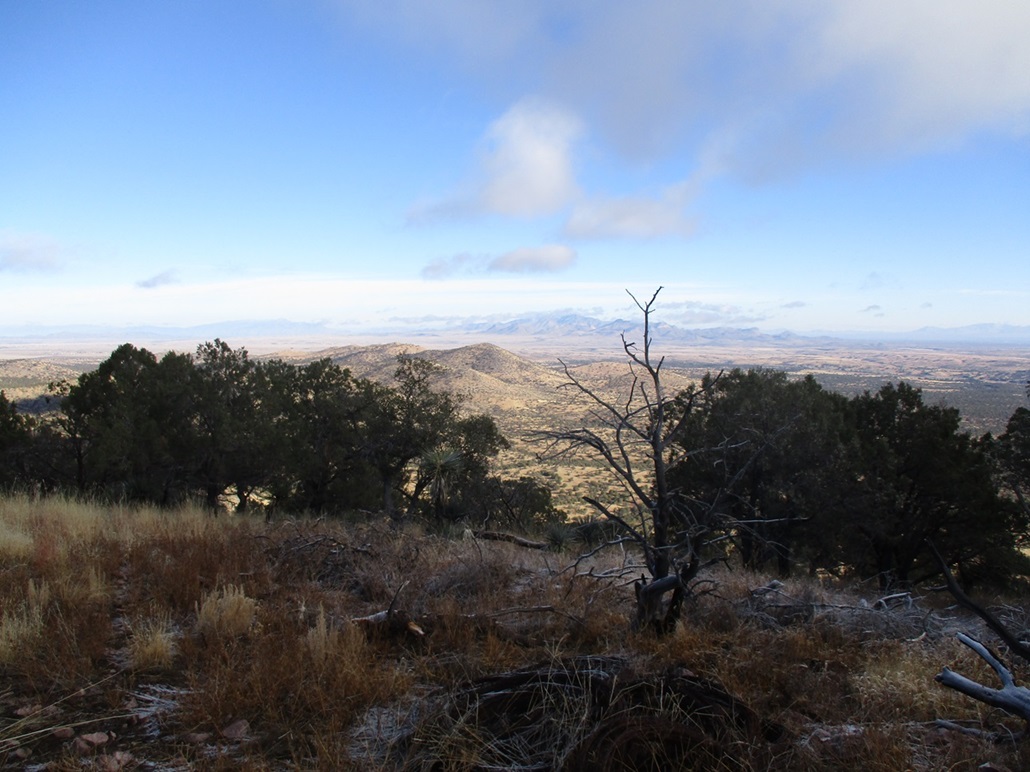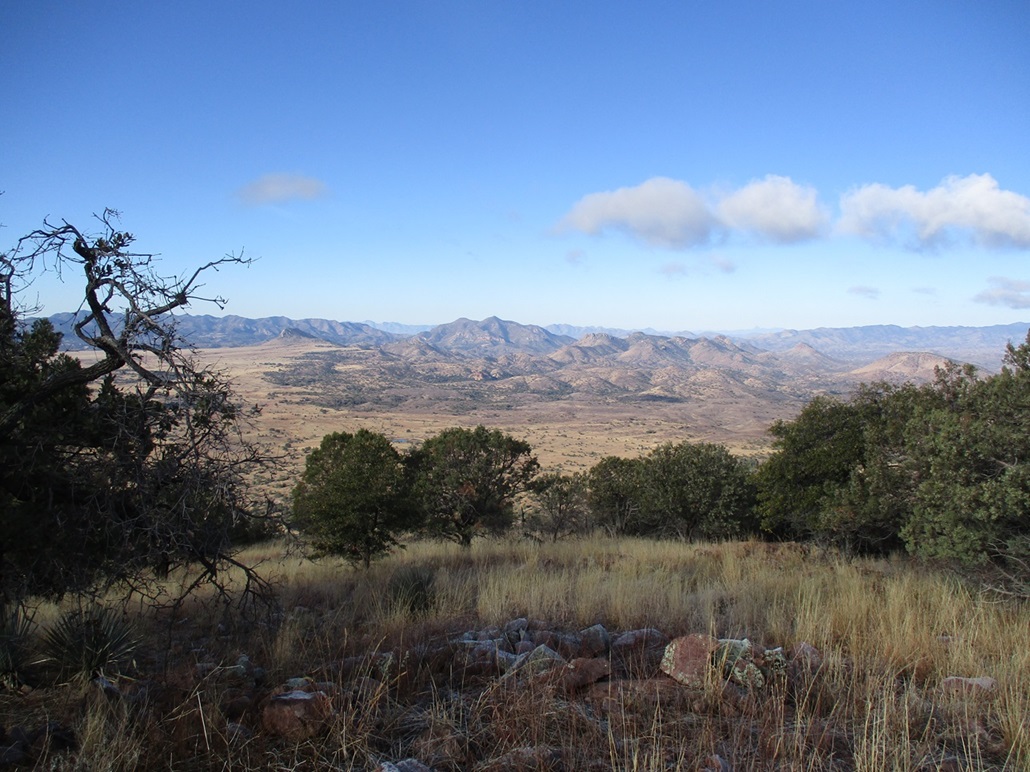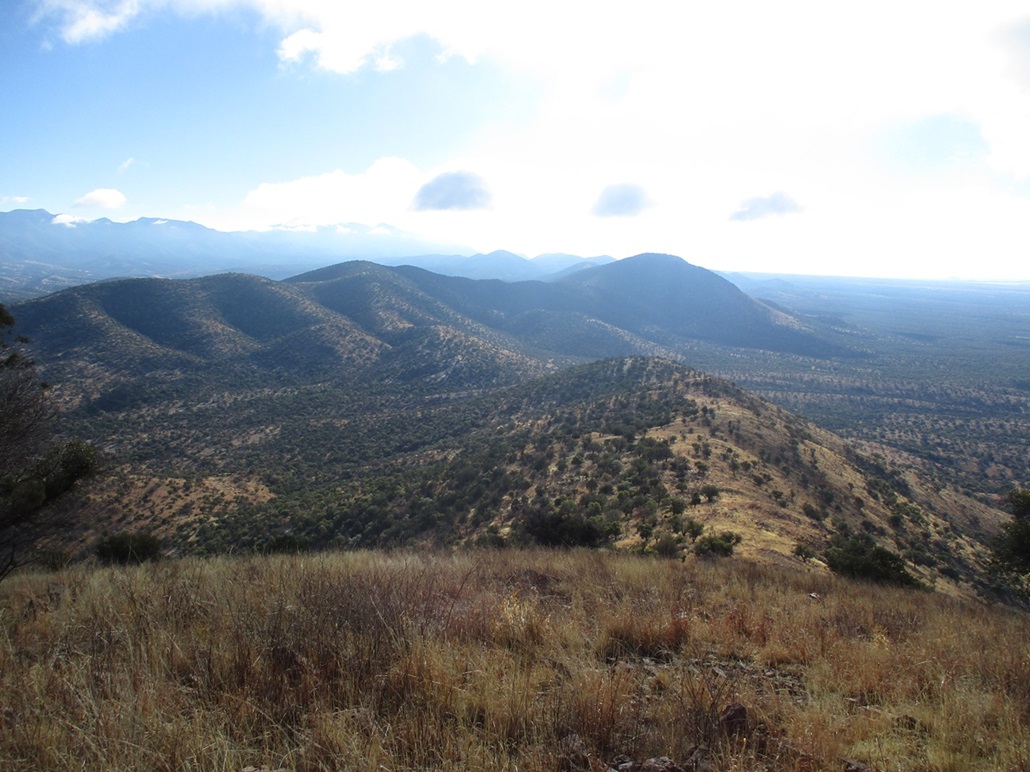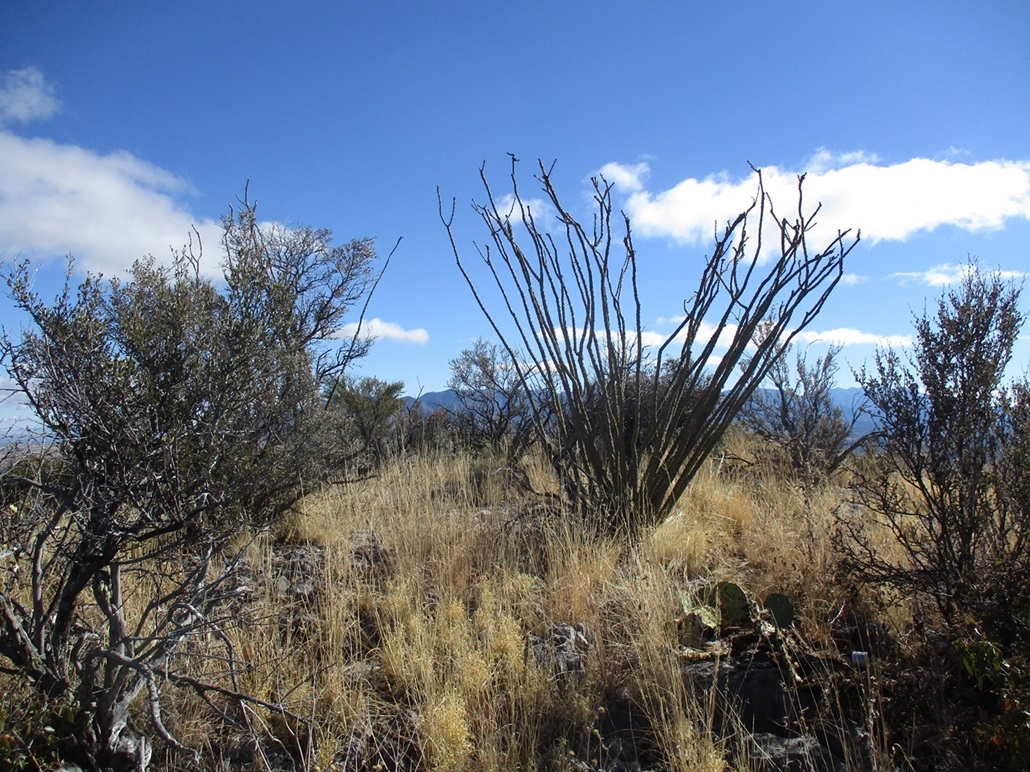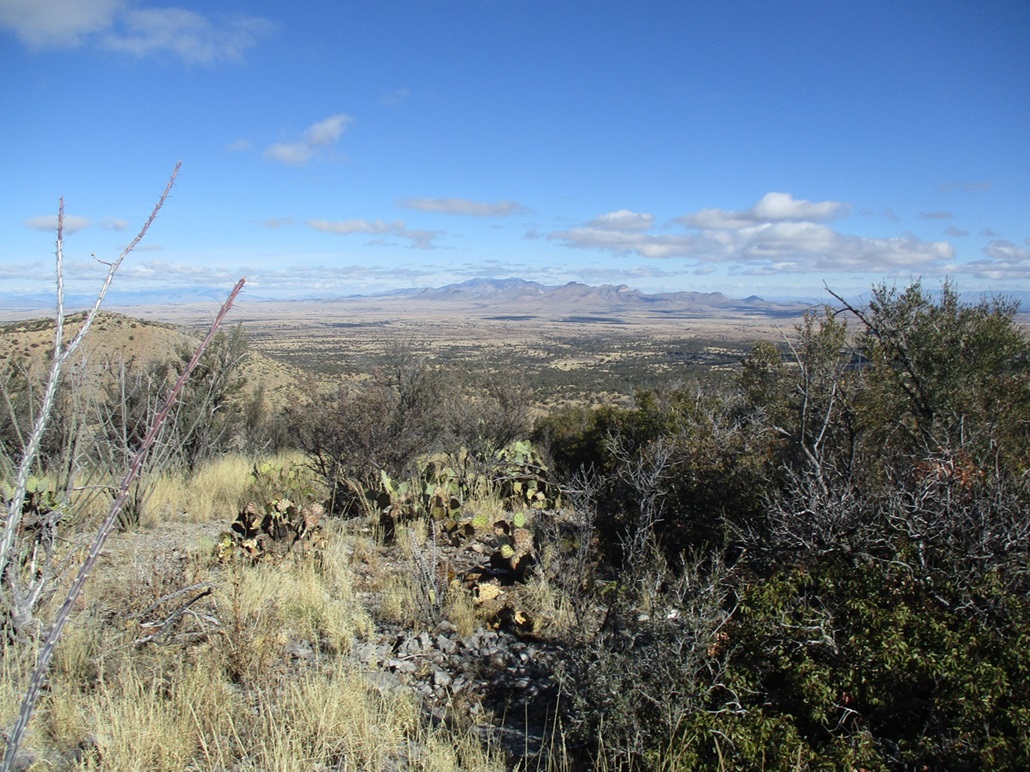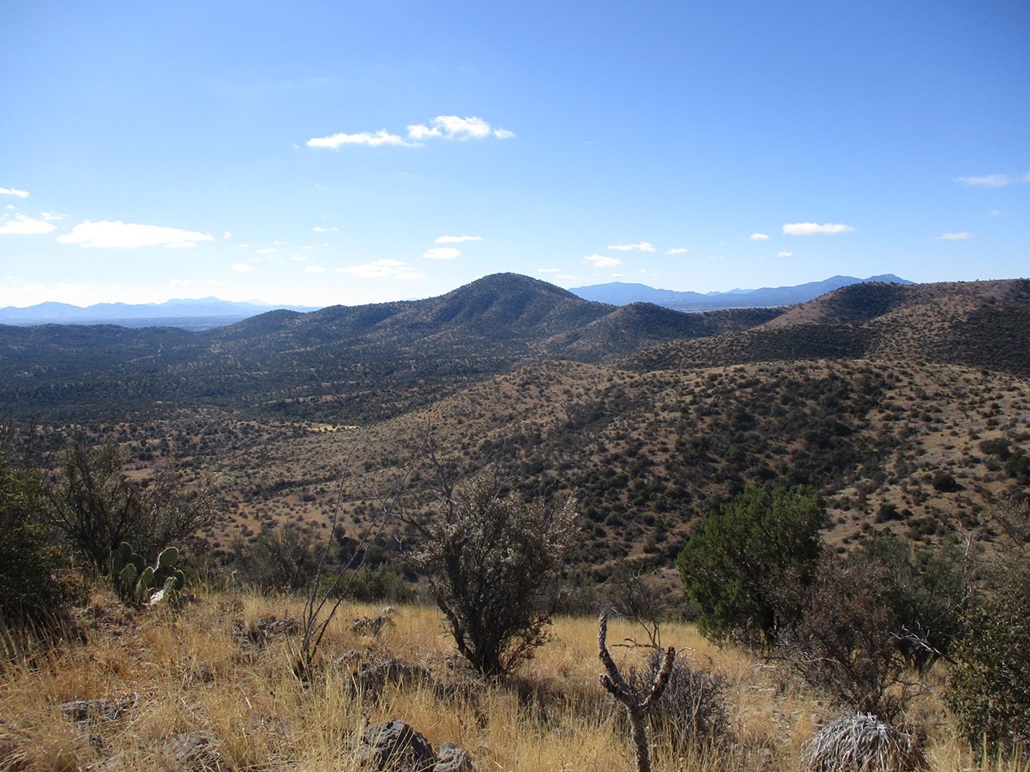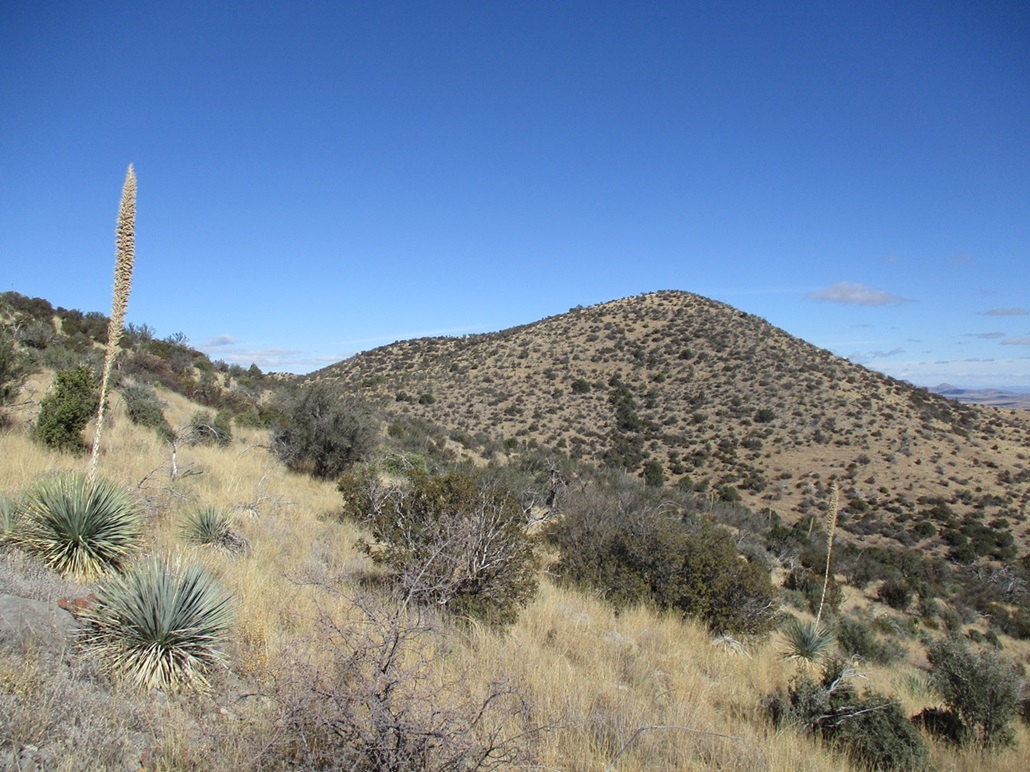
The Mountains of Arizona
www.surgent.net |
|
Pass Benchmark • Peak 5866 The Canelo Hills lie in southern Arizona, west of the Huachuca Mountains and east of the Patagonia Mountains, roughly ten to twenty miles north of the Mexican border. I have been here just one previous time, and that was about twenty years ago. I wanted to come back and explore, so I found one peak that I was pretty certain I could hike, and another that looked promising. I would use this also as an opportunity to reacquaint myself with the roads and the area for future trips here. I was up and out the door while still dark. Today was expected to be calm with mostly blue skies, but very cold. It was in the mid 20s when I got into my car, so I let it run for a few minutes to warm up and defrost the windows. I then followed routes AZ-80 and AZ-90 into Sierra Vista and north to Whetstone, and AZ-82 west, crossing into Santa Cruz County. I wanted highway AZ-83, which goes south and ends at Parker Lake, a recreational destination in the Coronado National Forest at the southeast tip of the Canelo Hills. However, I was able to cut off about fifteen miles by taking a paved connector through Elgin, catching AZ-83 a few miles south of the tiny village. I was already enjoying the tremendous scenery. The area around Elgin and points south was gently rolling grass rangeland that slowly segued into light forest as I approached the Canelo Hills. Elgin and the surrounding area are home to many wineries, this being Arizona's winery hub. Now on AZ-83, I kept on it for a few more miles until I crossed into the Coronado National Forest, then near the actual town of Canelo, stayed straight (south), now on Forest Road 799, which was ironic, because by day's end, I would be (hopefully) coming off my 799th ranked peak in Arizona. The two peaks on my agenda were visible: Pass Benchmark being the highest and most visually-obvious peak in the near distance, and Peak 5866, a rounded forest-and-grass peak about a mile and a half west of the road.
Date: January 5, 2024
• Elevation: 6,110 feet
• Prominence: 654 feet
• Distance: 1.8 miles
• Time: 1 hour
• Gain: 654 feet
• Conditions: Very cold but mostly clear with blue skies
Arizona
•
Main
•
PB
•
LoJ
•
USGS BM Datasheet
Forest Road 799 is a good road, well maintained and one of the main routes into and out of the scenic San Rafael Valley. I drove slowly, about 20 miles per hour, not to rush things. The road was a little wet and grabby from some rain and snow a day ago. I passed a Border Patrol vehicle along the way, and drove up to Canelo Pass, elevation 5,456 feet. Beyond the pass, the road drops steeply into the San Rafael Valley, which is very scenic and a place I recommend. A few movies have been shot here, Westerns and other movies where "expansive mountain and grassland scenery" is desired.
I parked in a small turnout just north of the fence at the pass. It was 8:40 a.m., and still quite cold, 29° said my car's thermometer. But it was very still and sunny, and not uncomfortable at all. Pass Benchmark rises about a mile to the west, and a trail supposedly goes most of the way to its top, going by what the satellite images showed. I bundled up, and stuffed my personal items in my jacket pockets, meaning that I didn't need to wear a pack for what looked to be a short hike. The Border Patrol guy drove up while I was getting situated and parked on the other side of the fence. I was expecting him to come and see what I was up to, but he never did.
I started hiking, following a very ragged track steeply uphill for a few hundred feet. This track has a severe sideways camber and I would not advise any vehicle on it. It simply ends anyway where a footpath picks up, there being no room to turn a vehicle around. For walking, the road was a little loose, but once on the path, things improved. The ground was covered in frost.
The path curls around a lower hill and gains to meet the ridge, the summit not too far away. A fenceline runs along the ridge and the path continues alongside the fence. The terrain was open with good long line-of-sight views. The path would often fade into nothingness but it did not matter since the fenceline served as a guide. And even then, one could see the top so navigation was trivial.
I hiked along the fence as long as it went up, looking for a spot to cross it. The fence actually veers away from the very top, cutting below the summit by about fifty feet. It is a newer, substantial fence, the usual barbed-wire type. The wires were taught and the lowest strand left little room to do a shimmy underneath. I finally found a spot I could step over using some rocks. Being tall helped.
The final few dozen feet went quickly and I was on top the simple grassy summit, on which sits a solar-powered repeater box, I'm sure used by the Border Patrol and probably the forest people. Views were outstanding, and the sun was still low enough to the east to provide nice shadows on distant peaks and valleys. I spent a few minutes wandering the summit, snapping photos, and signing in to the register, which I found near the benchmark, which itself is nearby the apparatus. The last signer-inner was from November, a guy up here to attend to the repeater. I'd like a job like that.
It was still quite chilly, but I still had to take off a layer. I estimated it to still be in the low 30s, just above freezing. The frost was still very frosty, if that gives any indication. If I stayed still, I got cold fast. If I moved, I actually got a little too warm. I was totally covered. Only my nose and chin felt the nip of the chill. My cheeks were well insulated by my bushy muttonchop sideburns.
I followed a slightly different route down off the peak, but it made no difference. Once down lower, I looked for a place to cross the fence, and found a spot where again I could carefully step over. I have always wondered why the barbs in the barbed-wire fences are necessary. The fence would still be functional without the barbs. All they did for me was catch my jeans in a couple spots, some a little too close to the family jewels.
The outbound hike didn't take long and I was back to my car, 62 minutes after departing. The BoPo guy had moved on. When I turned over the ignition, my "low tire pressure" gauge lit up. Bah. So I got out and inspected the tires. They all looked good, not even "kind of" low. There was no obvious hissing or leak, so I decided to continue on with my adventures and worry about the tires when I drive out.
Elevation: 5,866 feet
• Prominence: 316 feet
• Distance: 3.5 miles
• Time: 1 hour, 45 minutes
• Gain: 790 feet (gross)
• Conditions: Still cold but very nice overall
LoJ
I didn't have to drive very far, about a mile northbound on FR-799. I was looking for FR-4626 near "Western Well" as printed on the map. This track meandered west and passed below a subpeak of my next destination, Peak 5866. I hoped to drive in a little but only got in about a hundred feet, parking in a perfect little raised platform with flat ground and a fire ring. I started walking at 9:25 a.m..
I followed the road, which was marginal for a little while, then got really rough for a short segment, where my Subaru would not have handled it. A stock 4-wheel drive with decent clearance probably would be adequate. I stayed on the road about a little under a mile, passing through a gate along the way.
Once I could see the peak and the surrounding terrain good enough to sense a route, I left the road and started walking overland through tall grasses, clumps of trees and some rocky areas, aiming for a saddle south of the peak. For the time being, I was mainly on the lower slopes of the aforementioned subpeak, interpolated elevation of 5,735 feet. I generally went over more than up, as long as the terrain would allow that, trying to meet the saddle without extra elevation gain or loss.
The cross-country hiking was enjoyable, and the scenery was lovely. I was expecting heavier forest but I mainly had grassy slopes so I could see things easily. Alas, as I neared the saddle, there was a steep and rocky drainage between me and it, and I was obliged to hike more up before cutting over, which ultimately resulted in an extra gain of about 40 feet.
Once at the saddle, I hiked up the easy slopes of Peak 5866, following openings and lanes and stepping up the many small tiers of limestone rock. There was no challenge to this segment and I was on top the peak about 45 minutes after starting. The top was a little more brushy than over on Pass Benchmark. I found a summit cairn and register. The names went back 30 years, some nearly unreadable, but it was mostly the peak-bagging all-stars plus a random hunter or two, and some familiar names from back in the 1990s. The map shows a benchmark symbol but I saw no benchmark while here.
I took a break on a nice sitting limestone rock a few feet below the top, had a snack and drink, and looked around. It was still cool, but now pushing 40°, so it wasn't so chilly if I stayed still. I enjoyed the rest. The limestone rock is so rough to the touch, with sharp nubbins, that any scooting may result in a rip, so I made so not to do that.
For the outbound hike, I descended to the saddle and then ascended Peak 5735 rather than mess with the messy drainage. I found some paths up here, probably hunter and migrant paths. I did not see one single item of evidence of crossers here such as blackened water jugs, discarded jackets, and food wrappers. I'm sure they cross through here, though.
By staying high, I could choose when to descend, so I chose a path that placed me nearer the road so as to lessen the number of little arroyos to cross. I was back onto the road and back to my car, a 90-minute round trip hike covering about 3.5 miles. This turned out to be a lovely peak with nice lines and sufficient challenge to keep it interesting. I definitely recommend this one as a natural pairing with Pass Benchmark.
It was now about 11:30 a.m., and I was curious about my tires. They still looked fine. I think that they had naturally lost some air pressure from normal driving, and one went below the magical number to where my sensor picked up on it. Plus, the cold weather will often depress the tire pressure figures too. I have a plug-in air pump, but opted instead to drive out and make my way to Sonoita, where I knew they had a gas station with an air pump.
I followed the roads into Elgin, just for the scenery, then the connectors west and north into Sonoita, stopping in at the Chevron. Now on asphalt, I checked the air pressure and they all read between 20 psi to 30 psi. I filled them, but my tire gauge is one of those simple ones so when I'd check, it would either read 25 psi, or 40 psi. Had I overfilled them? It was frustrating not to get a dependable read, and this was while my $2 in quarters still ran the pump, so I did not want to have that stop on me.
I went inside and got some snacks, then checked the pressure again. They were variable but nothing concerning. But for piece of mind, I drove into Sierra Vista to a Discount Tire place where they did a check for me as part of their normal offerings. All this stupid little drama meant that any other peaks I might have been looking at got the boot for the day. I decided to head back to Bisbee and clean up. It had been a fruitful day in the Canelo (Cinnamon) Hills and I had a good time.
|
|
